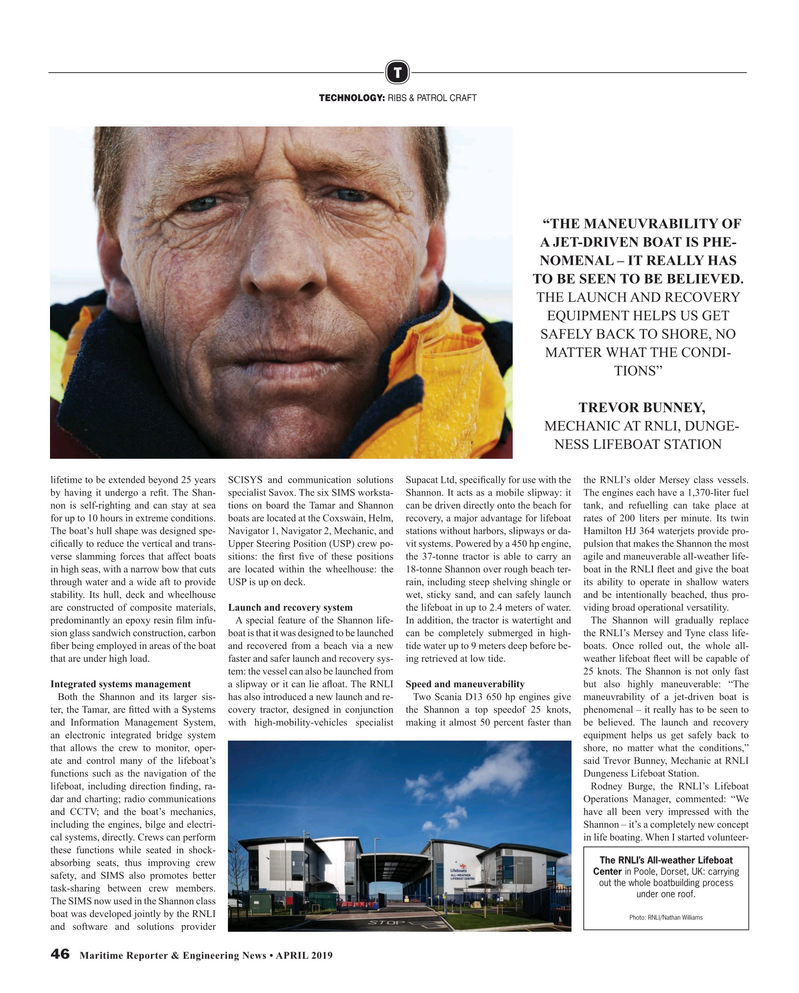
Page 46: of Maritime Reporter Magazine (April 2019)
Navies of the World
Read this page in Pdf, Flash or Html5 edition of April 2019 Maritime Reporter Magazine
T
TECHNOLOGY: RIBS & PATROL CRAFT “THE MANEUVRABILITY OF
A JET-DRIVEN BOAT IS PHE-
NOMENAL – IT REALLY HAS
TO BE SEEN TO BE BELIEVED.
THE LAUNCH AND RECOVERY
EQUIPMENT HELPS US GET
SAFELY BACK TO SHORE, NO
MATTER WHAT THE CONDI-
TIONS”
TREVOR BUNNEY,
MECHANIC AT RNLI, DUNGE-
NESS LIFEBOAT STATION lifetime to be extended beyond 25 years SCISYS and communication solutions Supacat Ltd, speci? cally for use with the the RNLI’s older Mersey class vessels. by having it undergo a re? t. The Shan- specialist Savox. The six SIMS worksta- Shannon. It acts as a mobile slipway: it The engines each have a 1,370-liter fuel non is self-righting and can stay at sea tions on board the Tamar and Shannon can be driven directly onto the beach for tank, and refuelling can take place at for up to 10 hours in extreme conditions. boats are located at the Coxswain, Helm, recovery, a major advantage for lifeboat rates of 200 liters per minute. Its twin
The boat’s hull shape was designed spe- Navigator 1, Navigator 2, Mechanic, and stations without harbors, slipways or da- Hamilton HJ 364 waterjets provide pro- ci? cally to reduce the vertical and trans- Upper Steering Position (USP) crew po- vit systems. Powered by a 450 hp engine, pulsion that makes the Shannon the most verse slamming forces that affect boats sitions: the ? rst ? ve of these positions the 37-tonne tractor is able to carry an agile and maneuverable all-weather life- in high seas, with a narrow bow that cuts are located within the wheelhouse: the 18-tonne Shannon over rough beach ter- boat in the RNLI ? eet and give the boat through water and a wide aft to provide USP is up on deck. rain, including steep shelving shingle or its ability to operate in shallow waters stability. Its hull, deck and wheelhouse wet, sticky sand, and can safely launch and be intentionally beached, thus pro- are constructed of composite materials, Launch and recovery system the lifeboat in up to 2.4 meters of water. viding broad operational versatility.
predominantly an epoxy resin ? lm infu- A special feature of the Shannon life- In addition, the tractor is watertight and The Shannon will gradually replace sion glass sandwich construction, carbon boat is that it was designed to be launched can be completely submerged in high- the RNLI’s Mersey and Tyne class life- ? ber being employed in areas of the boat and recovered from a beach via a new tide water up to 9 meters deep before be- boats. Once rolled out, the whole all- that are under high load. faster and safer launch and recovery sys- ing retrieved at low tide. weather lifeboat ? eet will be capable of tem: the vessel can also be launched from 25 knots. The Shannon is not only fast
Integrated systems management a slipway or it can lie a? oat. The RNLI Speed and maneuverability but also highly maneuverable: “The
Both the Shannon and its larger sis- has also introduced a new launch and re- Two Scania D13 650 hp engines give maneuvrability of a jet-driven boat is ter, the Tamar, are ? tted with a Systems covery tractor, designed in conjunction the Shannon a top speedof 25 knots, phenomenal – it really has to be seen to and Information Management System, with high-mobility-vehicles specialist making it almost 50 percent faster than be believed. The launch and recovery an electronic integrated bridge system equipment helps us get safely back to that allows the crew to monitor, oper- shore, no matter what the conditions,” ate and control many of the lifeboat’s said Trevor Bunney, Mechanic at RNLI functions such as the navigation of the Dungeness Lifeboat Station.
lifeboat, including direction ? nding, ra- Rodney Burge, the RNLI’s Lifeboat dar and charting; radio communications Operations Manager, commented: “We and CCTV; and the boat’s mechanics, have all been very impressed with the including the engines, bilge and electri- Shannon – it’s a completely new concept cal systems, directly. Crews can perform in life boating. When I started volunteer- these functions while seated in shock-
The RNLI’s All-weather Lifeboat absorbing seats, thus improving crew
Center in Poole, Dorset, UK: carrying safety, and SIMS also promotes better out the whole boatbuilding process task-sharing between crew members. under one roof.
The SIMS now used in the Shannon class boat was developed jointly by the RNLI
Photo: RNLI/Nathan Williams and software and solutions provider 46 Maritime Reporter & Engineering News • APRIL 2019
MR #4 (42-49).indd 46 4/2/2019 1:13:59 PM

 45
45

 47
47
